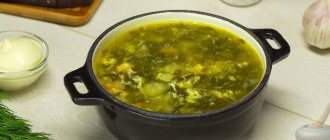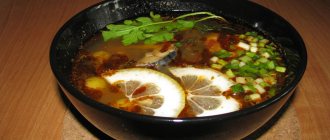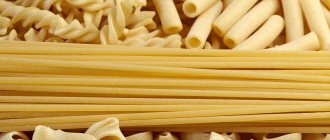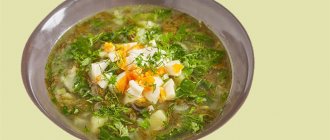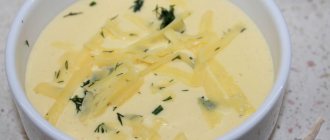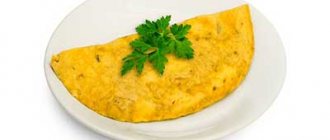Ingredients for water noodle soup
| Water | 2500 g |
| Boiled potatoes 1-206 | 800 g |
| Carrots, raw | 100 g |
| Bulb onions | 100 g |
| Sunflower oil | 30 g |
| dry vermicelli | 100 g |
Nutritional value and chemical composition of “noodle soup with water”.
The energy value of noodle soup with water is 39.3 kcal.
Primary Source: Created in the application by the user. Read more.
** This table shows the average levels of vitamins and minerals for an adult. If you want to know the norms taking into account your gender, age and other factors, then use the “My Healthy Diet” application.
This section presents the calorie content of noodle soup in various preparations, as well as the content of proteins, fats and carbohydrates. All data is provided per 100 grams of the finished product. To find out the content of BZHUK in a serving (plate), enter the required amount of product into the calculator.
1 standard serving of food (plate) = 250 grams.
Vermicelli soup recipe. Calorie, chemical composition and nutritional value.
Nutritional value and chemical composition of “Vermicelli soup”.
The table shows the nutritional content (calories, proteins, fats, carbohydrates, vitamins and minerals) per 100 grams of edible portion.
| Nutrient | Quantity | Norm** | % of the norm in 100 g | % of the norm in 100 kcal | 100% normal |
| Calorie content | 63.3 kcal | 1684 kcal | 3.8% | 6% | 2660 g |
| Squirrels | 5.9 g | 76 g | 7.8% | 12.3% | 1288 g |
| Fats | 1.9 g | 56 g | 3.4% | 5.4% | 2947 g |
| Carbohydrates | 5.7 g | 219 g | 2.6% | 4.1% | 3842 g |
| Organic acids | 0.1 g | ~ | |||
| Alimentary fiber | 0.6 g | 20 g | 3% | 4.7% | 3333 g |
| Water | 108.1 g | 2273 g | 4.8% | 7.6% | 2103 g |
| Ash | 0.5734 g | ~ | |||
| Vitamins | |||||
| Vitamin A, RE | 122.4 mcg | 900 mcg | 13.6% | 21.5% | 735 g |
| Retinol | 0.055 mg | ~ | |||
| beta carotene | 0.407 mg | 5 mg | 8.1% | 12.8% | 1229 g |
| Vitamin B1, thiamine | 0.051 mg | 1.5 mg | 3.4% | 5.4% | 2941 g |
| Vitamin B2, riboflavin | 0.159 mg | 1.8 mg | 8.8% | 13.9% | 1132 g |
| Vitamin B4, choline | 5.28 mg | 500 mg | 1.1% | 1.7% | 9470 g |
| Vitamin B5, pantothenic | 0.138 mg | 5 mg | 2.8% | 4.4% | 3623 g |
| Vitamin B6, pyridoxine | 0.112 mg | 2 mg | 5.6% | 8.8% | 1786 |
| Vitamin B9, folates | 4.523 mcg | 400 mcg | 1.1% | 1.7% | 8844 g |
| Vitamin B12, cobalamin | 0.136 mcg | 3 mcg | 4.5% | 7.1% | 2206 g |
| Vitamin C, ascorbic acid | 3.66 mg | 90 mg | 4.1% | 6.5% | 2459 g |
| Vitamin D, calciferol | 0.014 mcg | 10 mcg | 0.1% | 0.2% | 71429 g |
| Vitamin E, alpha tocopherol, TE | 0.105 mg | 15 mg | 0.7% | 1.1% | 14286 g |
| Vitamin H, biotin | 0.333 mcg | 50 mcg | 0.7% | 1.1% | 15015 g |
| Vitamin K, phylloquinone | 3.8 mcg | 120 mcg | 3.2% | 5.1% | 3158 g |
| Vitamin RR, NE | 2.7422 mg | 20 mg | 13.7% | 21.6% | 729 g |
| Niacin | 1.619 mg | ~ | |||
| Macronutrients | |||||
| Potassium, K | 226.31 mg | 2500 mg | 9.1% | 14.4% | 1105 g |
| Calcium, Ca | 9.11 mg | 1000 mg | 0.9% | 1.4% | 10977 g |
| Magnesium, Mg | 15.45 mg | 400 mg | 3.9% | 6.2% | 2589 g |
| Sodium, Na | 16.75 mg | 1300 mg | 1.3% | 2.1% | 7761 g |
| Sera, S | 22.89 mg | 1000 mg | 2.3% | 3.6% | 4369 g |
| Phosphorus, P | 71.8 mg | 800 mg | 9% | 14.2% | 1114 g |
| Chlorine, Cl | 19.92 mg | 2300 mg | 0.9% | 1.4% | 11546 g |
| Microelements | |||||
| Aluminium, Al | 239.2 mcg | ~ | |||
| Bor, B | 34.6 mcg | ~ | |||
| Vanadium, V | 38.49 mcg | ~ | |||
| Iron, Fe | 1.15 mg | 18 mg | 6.4% | 10.1% | 1565 g |
| Yod, I | 3.23 mcg | 150 mcg | 2.2% | 3.5% | 4644 g |
| Cobalt, Co | 1.829 mcg | 10 mcg | 18.3% | 28.9% | 547 g |
| Lithium, Li | 19.798 mcg | ~ | |||
| Manganese, Mn | 0.1054 mg | 2 mg | 5.3% | 8.4% | 1898 |
| Copper, Cu | 56.33 mcg | 1000 mcg | 5.6% | 8.8% | 1775 g |
| Molybdenum, Mo | 2.784 mcg | 70 mcg | 4% | 6.3% | 2514 g |
| Nickel, Ni | 1.797 mcg | ~ | |||
| Tin, Sn | 3.96 mcg | ~ | |||
| Rubidium, Rb | 136.9 mcg | ~ | |||
| Selenium, Se | 1.325 mcg | 55 mcg | 2.4% | 3.8% | 4151 g |
| Fluorine, F | 12.35 mcg | 4000 mcg | 0.3% | 0.5% | 32389 g |
| Chromium, Cr | 3.05 mcg | 50 mcg | 6.1% | 9.6% | 1639 g |
| Zinc, Zn | 0.3338 mg | 12 mg | 2.8% | 4.4% | 3595 g |
| Digestible carbohydrates | |||||
| Starch and dextrins | 3.654 g | ~ | |||
| Mono- and disaccharides (sugars) | 0.9 g | max 100 g | |||
| Glucose (dextrose) | 0.2535 g | ~ | |||
| Sucrose | 0.369 g | ~ | |||
| Fructose | 0.0767 g | ~ | |||
| Essential amino acids | 0.1976 g | ~ | |||
| Arginine* | 0.0381 g | ~ | |||
| Valin | 0.0436 g | ~ | |||
| Histidine* | 0.0142 g | ~ | |||
| Isoleucine | 0.0333 g | ~ | |||
| Leucine | 0.0518 g | ~ | |||
| Lysine | 0.042 g | ~ | |||
| Methionine | 0.0111 g | ~ | |||
| Methionine + Cysteine | 0.0137 g | ~ | |||
| Threonine | 0.033 g | ~ | |||
| Tryptophan | 0.0109 g | ~ | |||
| Phenylalanine | 0.039 g | ~ | |||
| Phenylalanine+Tyrosine | 0.051 g | ~ | |||
| Nonessential amino acids | 0.3276 g | ~ | |||
| Alanin | 0.0349 g | ~ | |||
| Aspartic acid | 0.0803 g | ~ | |||
| Glycine | 0.036 g | ~ | |||
| Glutamic acid | 0.1642 g | ~ | |||
| Proline | 0.0515 g | ~ | |||
| Serin | 0.0462 g | ~ | |||
| Tyrosine | 0.0305 g | ~ | |||
| Cysteine | 0.0117 g | ~ | |||
| Sterols (sterols) | |||||
| Cholesterol | 4.23 mg | max 300 mg | |||
| Saturated fatty acids | |||||
| 14:0 Miristinovaya | 0.0005 g | ~ | |||
| 16:0 Palmitinaya | 0.0221 g | ~ | |||
| 18:0 Stearic | 0.004 g | ~ | |||
| Monounsaturated fatty acids | 0.0455 g | min 16.8 g | 0.3% | 0.5% | |
| 16:1 Palmitoleic | 0.0014 g | ~ | |||
| 18:1 Oleic (omega-9) | 0.0439 g | ~ | |||
| Polyunsaturated fatty acids | 0.0303 g | from 11.2 to 20.6 g | 0.3% | 0.5% | |
| 18:2 Linolevaya | 0.0294 g | ~ | |||
| 18:3 Linolenic | 0.0213 g | ~ |
The energy value of vermicelli soup is 63.3 kcal.
Primary Source: Created in the application by the user. Read more.
** This table shows the average levels of vitamins and minerals for an adult. If you want to know the norms taking into account your gender, age and other factors, then use the “My Healthy Diet” application.
Calorie content of all noodle soups in a row:
Didn't find the product or dish you were looking for?
Let us know in a comment and we will add it:
The calorie content of soups can be very varied, as well as the number of recipes and their preparation.
Soups are essentially decoctions of vegetables with or without meat. People began to cook various vegetable mixtures back in ancient times, seasoning dishes with various seasonings, roots and leaves of plants to enhance and improve the taste. No one will argue that the most delicious broth is obtained from meat broth, although the calorie content of soup with meat is much higher than that of vegetables. To prepare soups, it is customary to use various meats - pork, chicken, beef and even fish. In Rus', such decoctions were called “pottage” and they were considered, however, as now, the main dish of every home.
From year to year, culinary masters improved and developed new recipes for preparing this delicious dish. Therefore, today the number of recipes for making soup simply cannot be counted. Many women who watch their figure are interested in questions such as whether it is possible to lose weight on soups, what is the calorie content of puree soup. And those who are quite satisfied with their figure often search on the Internet for recipes and calorie content of noodle soup, or information about the calorie content of meatball soup.
What are the benefits of soups?
Any soup is an excellent source of strength and energy. The soup contains a lot of fiber, carbohydrates and minerals (magnesium, iron, potassium, etc.), vitamins (E, beta-carotene, group B).
In addition, in boiled vegetables during the preparation of soups, most of the beneficial properties are retained, and they are absorbed and digested much better by the body. Yushka made from vegetable broth is also healthy and has great nutritional value, since vitamins and minerals from vegetables are washed out into the broth.
Regardless of the calorie content of soups, they are simply irreplaceable for the human body:
- Improve appetite and digestion;
- Restore the functioning of the gastrointestinal tract;
- Normalize blood pressure;
- Restore fluid balance in the body;
- Reduce cholesterol levels;
- Cleanse the body of toxins;
- Protects against cardiovascular diseases.
Therefore, many try not only to lose weight with soups, but also include them in therapeutic diets. Well, the ability of soups to restore strength after long-term illnesses and warm up the body during the cold season is no secret to anyone.
Myths and misconceptions
The idea that this poultry is ideal for those who want to lose weight is complete nonsense. Chicken meat is considered dietary in the sense that it is most easily absorbed by the body, even when it is weakened by blood loss or a long-term serious illness. That is, a person does not waste energy, which he already does not have enough, on digesting “difficult” food and receives enough food to replenish vital energy.

How many calories are in soup?
Despite the fact that soups do not have a particularly high calorie content, it would not be superfluous to think about what, for example, the calorie content of cream soup or any other soup is. Actually, the calorie content of soup directly depends on the products from which it is prepared.
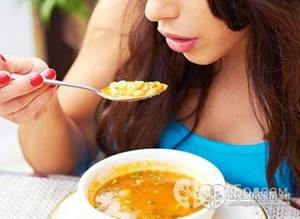
In general, among all food products, soups are one of the lowest calorie dishes. This is why many people try to lose weight with soups, and they succeed. However, often additional ingredients are added to a ready-made dish, which increase the calorie content of the soup. For example, high-fat sour cream or mayonnaise greatly increases the calorie content of a dish, so you should not get too carried away with them.
Below is the calorie content of soups prepared from various products:
- Ukrainian borscht – 49 kcal per 100 ml;
- Pea soup – 100 ml 66 kcal;
- Mushroom soup – 100 ml 26 kcal;
- Green pea soup – 100 ml 56 kcal;
- Leek soup with pasta – 39 kcal per 100 ml;
- Tomato soup – 100 ml 28 kcal;
- Potato soup – per 100 ml 39 kcal;
- Potato soup with cereals – 54 kcal per 100 ml;
- The calorie content of noodle soup is 48 kcal per 100 ml;
- Vegetable soup – 43 kcal per 100 ml;
- The calorie content of meatball soup is 75 kcal per 100 ml;
- Puree soup calorie content on average is 48 kcal per 100 ml;
- Ear - 46 kcal per 100 ml.
Found an error in the text? Select it and press Ctrl + Enter.
Any soup is a source of energy and strength.
The dish is rich in fiber, carbohydrates, minerals and vitamins, as it mainly consists of vegetables, cereals and meat products.
Knowing how many calories are in soup, you can lose weight or gain missing kilograms.
There are special tables with data on the nutritional value of such food. They are used when wanting to lose excess weight and when creating therapeutic diets.
- Calorie table for soups and their nutritional value
- Secrets on how to reduce the calorie content of soup
- Cook with low-calorie foods
- Do not fry vegetables
- Use skinless meat
- Avoid fatty sauces
- Drain the first broth
- Do not use sour cream
- Conclusion
Calorie table for soups and their nutritional value
The nutritional value of the main types of first courses is presented in the table:
| Soup name | Calorie content (kcal per 100 ml) |
| Chicken | 36 |
| Pea | 66 |
| Mushroom | 26 |
| Kharcho | 67 |
| With meatballs | 45,5 |
| Buckwheat | 33,6 |
| With vermicelli | 48 |
| Vegetable puree soup with chicken broth | 58,2 |
| Vegetable puree soup with meat broth | 21,1 |
| Sauerkraut cabbage soup | 32 |
| Cabbage soup with sour cream (depending on the fat content of sour cream) | 37,1-51,44 |
| Rassolnik | 42 |
| Solyanka (with beef and tomato) | 100 |
| Borsch | 49 |
| Minestrone (vegetable soup) | 39 |
| Beans with pepper | 63 |
| Onion with carrots | 44 |
| Potato | 38 |
Recipes for the most delicious soups and their calorie content
Eggplant puree soup is ideal for a diet. Take 600 g of fresh eggplant, 1 onion, a tablespoon of balsamic vinegar, 2 cloves of garlic, fresh thyme, salt, and olive oil to taste in 500 ml of water. Chop the eggplants, thyme, garlic, mix it all, add vinegar and fry in olive oil in a frying pan until tender. Separately, fry the crushed garlic and onion in oil in a saucepan, add the eggplants, cover with water and cook for 20 minutes, then grind in a blender. The calorie content of eggplant puree soup is 18 kcal per 100 grams. The calorie content of noodle soup with chicken broth is 62 kcal per 100 grams.
Hearty chicken noodle soup is not suitable for dietary nutrition, but it is quite suitable for recharging your strength and energy. For 3 legs, take 3 potatoes, half a glass of noodles, an onion, a carrot, a bunch of fresh herbs, pepper, and salt to taste. Put the legs to cook, after the water boils, put the unpeeled, cleanly washed onion into the pan. After 30 minutes, take it out, put the carrots cut into small cubes into the pan, and 5 minutes after that - the potatoes. Cook for another 15 minutes, add vermicelli and cook for another 15 minutes. Add the spices, turn off the soup and let it sit for 10 minutes before serving. The calorie content of soup with noodles and chicken is 132 kcal per 100 g.
Very tasty and healthy tomato soup with meatballs . For 2.5 liters of meat broth you will need 500 g of tomatoes, 400 g of onions, 300 g of minced meat, a glass of 40% cream, 100 g of vermicelli, 4 tablespoons of tomato paste, a tablespoon of red pepper, 2 bay leaves, salt , herbs, spices to taste. Add bay leaf to the broth and put on fire, add spices, pepper and onions cut into quarters. Cook for 20 minutes. Take the minced meat, make small meatballs from it and put them in the pan. Add chopped tomatoes and tomato paste, stir, add vermicelli. When the water boils, turn on low heat and cook for 10 minutes, stirring. Then add salt and pepper. When the soup is ready, add cream and fresh parsley. Serve the soup with hot white toast or crispy fresh bread. The calorie content of soup with meatballs and tomatoes is 55 kcal per 100 g.
Anyone who loves mushroom soup will appreciate this recipe. Take 4 potatoes, 1 onion, 100 g vermicelli, 60 g dried porcini mushrooms, carrots, spices and salt to taste. Soak the mushrooms for 10-15 minutes, then drain the water. Place a pot of water on a hot stove. Chop the onion, grate the carrots on a coarse grater and fry them together in olive oil. When the water in the pan boils, add mushrooms and fried onions and carrots. Place peeled and chopped potatoes there. After 15-20 minutes, add vermicelli, herbs, spices, salt to the pan, turn off the heat and leave for 10-15 minutes. The soup is served with sour cream and herbs. Calorie content of soup with noodles and mushrooms is 110 kcal per 100 g.
The most effective exercises for slender legs
Secrets on how to reduce the calorie content of soup
Body weight directly depends on the nutritional value of the soups consumed.
Nutritionists have calculated that a daily decrease in the energy value of a dish by just 100 kcal prevents the appearance of 1 kg of excess weight per year.
There are several simple rules, following which you can get rid of 500 grams of fat every week.
Cook with low-calorie foods
Many dishes will not lose their taste (or gain it) if their ingredients are changed.
For example, you can safely change components:
- whole milk – low-calorie;
- butter - olive oil or any vegetable oil;
- fatty meat (sausage, ham) - fish or lean veal;
- cereals - for vegetables and herbs;
- mayonnaise - for natural yogurt;
- sugar – for fructose, etc.
Important! It is advisable not to use starch, potatoes, rice, flour, sugar, seasonings with a high salt content, or canned foods when preparing dishes.
Do not fry vegetables
Fried food adds at least 150 kcal to each soup. An alternative is raw or steamed vegetables.
Use skinless meat
The main source of carbohydrates and fats is found not in the chicken flesh itself, but in its skin. When cooking meat, the skin must be removed.
Avoid fatty sauces
A good alternative to mayonnaise, full-fat sour cream and ketchup would be mustard, lemon or homemade pesto sauce with garlic and basil, natural yogurt, balsamic vinegar, etc.
Drain the first broth
When cooking broth, the first portion must be drained - it is full of antibiotics and chemicals that the animal consumed along with the food. The second broth is healthier and cleaner.
Do not use sour cream
Sour cream is a fairly fatty product. It is best to replace it with natural yogurt, mustard or homemade tomato paste.
Ingredients and how to cook
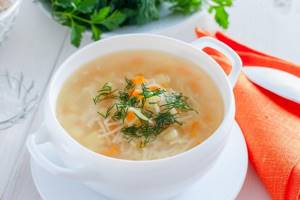
ingredients for 6 servings or - the number of products for the servings you need will be calculated automatically!'>
| tea spoon | 5 ml |
| dessert spoon | 10 ml |
| tablespoon | 20 ml |
| cup | 200 ml |
Total:
| Composition weight: | 100 gr |
| Calorie composition: | 51 kcal |
| Belkov: | 3 g |
| Zhirov: | 2 g |
| Carbohydrates: | 5 g |
| Used: | 30 / 20 / 50 |
| H 100 / C 0 / B 0 | |
Cooking time: 50 min
Step-by-step preparation
Step 1:
To prepare chicken noodle and potato soup, you must first cook the broth. I used a soup kit, but you can use any part of the chicken. Rinse the chicken well, place in a saucepan, cover with cold, high-quality filtered water and put on fire. When the broth boils, reduce the heat, remove the scum and simmer over medium heat, without letting the broth boil, for 15-20 minutes. Do not cover the pan with a lid.
Step 2:
Peel the onions and carrots, cut into small cubes. To prevent onion juice from irritating your eyes so much, rinse the onion and knife under running cold water. Place the prepared vegetables into the broth being prepared. Add half a tablespoon of salt. At the end of cooking the chicken soup, you can add salt to the dish to your liking. Cook the chicken and vegetables for 20 minutes over low heat, avoiding boiling.
Step 3:
Wash the potatoes, peel them, cut them into small cubes and add them to the soup. Cook for another 15 - 20 minutes after boiling.
Step 4:
Add vermicelli to the soup, salt and pepper to taste. Add bay leaf if desired. Keep the soup on the fire for 2 minutes and turn off the heat. If you want, add spices to taste. Instead of vermicelli, you can use other pasta.
Step 5:
Let the finished chicken soup with noodles and potatoes brew for at least 10 minutes. Then serve. Add fresh chopped herbs (parsley, dill, green onions) to taste.
The amount of water indicated in the recipe can be reduced or increased according to your wishes, depending on whether you want a thicker or thinner soup.
The chicken can be replaced with turkey or any other type of meat you wish. But keep in mind that in this case the cooking time and calorie content of the dish will change.
Since the degree of saltiness, sweetness, bitterness, pungency, acidity, pungency is individual for everyone, always add spices, herbs and seasonings, focusing on your taste! If you are adding some of the seasonings for the first time, then keep in mind that there are spices that are especially important not to add (for example, chili pepper).
There are 27 calories in Mushroom Soup. per 100 grams.
Classic mushroom soup is one of the lowest calorie first courses. Additionally, you can reduce calorie content if you do not fry carrots and onions in vegetable oil, but add them raw. A level spoon of sour cream added to the soup will increase the number of calories in a serving by 40 kcal. 100 grams of the Mushroom Soup product contains:
- Water - 63 g;
- Potatoes - 15 g;
- Mushrooms - 13 g;
- Onion - 4 g;
- Carrots - 4 g;
- Vegetable oil - 1 g;
Most nutritionists recommend eating light soups, which will promote the proper functioning of the digestive system and intestines. One of these is chicken noodle soup, the calorie content of which is insignificant, and therefore you don’t have to be afraid that it will somehow affect your figure.
What are the benefits of soup?
Due to its beneficial properties and rapid absorption of all ingredients, chicken broth soup is recommended for all people who have problems with the gastrointestinal tract. Doctors also prescribe it to restore the body of patients during periods of illness and after undergoing operations. At the same time, there are few calories in chicken soup, which means you can consume it quite often and without fear of gaining weight.
You can make soup using various parts of chicken, but the most common is the breast. This option is truly dietary. Chicken soup with noodles made from legs or other parts of the body has a slightly higher calorie content. At the same time, if you want to reduce the fat content in the first dish, then you need to strain it. Another way to remove fat is to remove the top layer from the broth.
How many calories are in chicken soup?
Calories in chicken noodle soup can range from 40 to 84 kcal per hundred grams of product. It depends on what other ingredients are added during the cooking process. So, for example, using meat, noodles, herbs and spices will give you up to 40 kcal, and if you add a little more mushrooms and potatoes, then the figure will become even higher. In this case, its nutritional value will be as follows: proteins - about 6 g, fats - 5 g, and carbohydrates - approximately 7.5-8 g.
Chicken noodle soup, the calorie content of which can vary not only from the composition, but also from the type of meat, can be quite fatty. This depends on whether you removed the skin from the meat or not. It is the skin that contains the largest amount of cholesterol, and therefore it is advisable to remove it before cooking.
How to properly prepare broth?
To prepare chicken noodle soup with minimal calories but maximum nutritional content, you need the following:
- Pour plenty of water over the brisket and bring to a boil.
- After noise appears, drain the water and refill with clean water.
- Boil the brisket until completely cooked. If desired, you can strain the broth, and then add some potatoes (or better without them), vegetables and noodles.
Chicken noodle soup - calories
Most nutritionists recommend eating light soups, which will promote the proper functioning of the digestive system and intestines. One of these is chicken noodle soup, the calorie content of which is insignificant, and therefore you don’t have to be afraid that it will somehow affect your figure.
What are the benefits of soup?
Due to its beneficial properties and rapid absorption of all ingredients, chicken broth soup is recommended for all people who have problems with the gastrointestinal tract. Doctors also prescribe it to restore the body of patients during periods of illness and after undergoing operations. At the same time, there are few calories in chicken soup, which means you can consume it quite often and without fear of gaining weight.
You can make soup using various parts of chicken, but the most common is the breast. This option is truly dietary. Chicken soup with noodles made from legs or other parts of the body has a slightly higher calorie content. At the same time, if you want to reduce the fat content in the first dish, then you need to strain it. Another way to remove fat is to remove the top layer from the broth.
How many calories are in chicken soup?
Calories in chicken noodle soup can range from 40 to 84 kcal per hundred grams of product. It depends on what other ingredients are added during the cooking process. So, for example, using meat, noodles, herbs and spices will give you up to 40 kcal, and if you add a little more mushrooms and potatoes, then the figure will become even higher. In this case, its nutritional value will be as follows: proteins - about 6 g, fats - 5 g, and carbohydrates - approximately 7.5-8 g.
Chicken noodle soup, the calorie content of which can vary not only from the composition, but also from the type of meat, can be quite fatty. This depends on whether you removed the skin from the meat or not. It is the skin that contains the largest amount of cholesterol, and therefore it is advisable to remove it before cooking.
How to properly prepare broth?
To prepare chicken noodle soup with minimal calories but maximum nutritional content, you need the following:
- Pour plenty of water over the brisket and bring to a boil.
- After noise appears, drain the water and refill with clean water.
- Boil the brisket until completely cooked. If desired, you can strain the broth, and then add some potatoes (or better without them), vegetables and noodles.
Composition of nutrients, BJU
Chicken soup with vegetables
| For quantity: 100 grams | ||
| Calories - 43 | Calories from fat - 8 | |
| BJU | ||
| Total fat content | 0.92g | |
| Saturated | 0.2g | |
| Polyunsaturated | 0g | |
| Monounsaturated | 0g | |
| Cholesterol | 6mg | |
| Total carbohydrate content | 6.32g | |
| Dietary fiber | 1g | |
| Sugar | 1.02g | |
| Squirrels | 2.45g | |
Distribution of calories for BJU:
Calories in chicken soup
How to calculate the calorie content of chicken soup? The nutritional value, as well as the calorie content of chicken soup, will change if you remove the skin from the chicken before cooking the broth. It is also of great importance which part to cook chicken soup from. The breast is the least fatty part of the bird, and the fattest parts are the back and wings. In general, the most fatty and high-calorie part of chicken is the skin, but while it’s easy to remove the skin from the breast, it’s very difficult to remove the skin from the wings. They have little meat and a lot of fat. Therefore, if you cook chicken soup from wings, its calorie content per 100 grams will be significantly higher than that of the first course made from breast.
Calories in chicken broth soup
The calorie content of chicken soup is low - 80 kcal per hundred grams of soup. And this is not surprising, given the fact that this dish is classified as dietary. The calorie content of chicken broth soup depends on how it is prepared. For example, the calorie content of chicken soup with potatoes is not very high, even if you consider that potatoes are vegetables with a high starch content. And the calorie content of chicken noodle soup is higher, especially if the noodles are homemade. It should be noted that chicken soup with rice has the lowest calorie content. The calorie content of chicken broth soup also depends on what part of the chicken it is made from. For example, soup made from chicken breast will be considered the lowest in calories.
Useful tips
- To achieve a beautiful yellow color and good transparency for the broth, just before boiling, you need to reduce the intensity of the flame and remove the scale, which is a failure product of the reaction of coagulated blood and hardness salts. This way you remove the most harmful substances from the future dish;
- If you want to reduce the calorie content of the broth, strain it twice through cheesecloth or simply skim off the fat on top with a spoon;
- There is no need to fry onions and carrots; it is better to put them raw in the soup;
- It is necessary to add vermicelli at the end of cooking. Having done this at the beginning, it will boil and the soup will turn into jelly;
- To add additional color to the chicken broth, add a coarsely chopped onion during cooking;
- The potatoes are chopped into medium strips or small cubes;
- If you are using fresh herbs, add them at the end of cooking. Suitable: dill, parsley, basil.
For noodle soup, it is better to take homemade chicken; its taste and richness cannot be compared with store-bought chicken. You can add pickled tomatoes without peel to it. Treat your loved ones with an exclusive dish from the restaurant menu!
Calorie table for soups for diet
Soups are very beneficial for the body. They are easily digested, stimulate digestion, contain vitamins and microelements and nourish the body well. Also, they contain very few calories, so they are well suited for dietary nutrition and nursing patients. Some soups, such as fish soup and chicken broth, are good for viral diseases. They strengthen the body, soften coughs and even act as an antipyretic. At their core, soups are decoctions of a mixture of vegetables with or without meat. For diets, vegetable soups are most often used (Bonn soup, vegetable soup, onion soup, etc.). The variety of soups is huge and you yourself can easily become the author of such a recipe. It is enough to change the quantity and composition of ingredients - and the new soup is ready.
Most soups contain a minimal amount of calories. When cereals, pasta, and fats are added to soup, their calorie content increases significantly. And meat broths only slightly increase the calorie content. In addition to calories, soups nourish our body with vitamins, microelements, and ballast substances.
What are the benefits of soups for the body?
Soups contain water, which is so necessary for the body. Vegetable fiber is easily digestible due to heat treatment. However, it should be remembered that the less vegetable soup is cooked, the more beneficial it is.
Of particular note are the vegetable soups. Due to their low calorie content, they are widely used in diets.
In addition, mushrooms and vegetables are best consumed boiled. It is during cooking that the most beneficial substances are retained in vegetables and mushrooms.
Vegetable soups stimulate metabolism and improve the functioning of the digestive tract. The process of losing weight with vegetable soups occurs without the feeling of hunger and results in significant weight loss. In addition, vegetable soups cleanse the body well.
Calorie content of soups. Which soup has the least calories?
Soups can be safely classified as low-calorie foods. Sometimes there is confusion about the calorie content of soups, but this is due to the fact that some sources give the calorie content of soups per serving, and not per 100 grams. And, as you know, a portion, in terms of GOST in ulinaria, is 250 grams.
The calorie content of the soup will depend entirely on the ingredients that were used in its preparation. For example, the calorie content of beef broth is 26 calories, but if you use fatty meat to prepare it, the calorie content will increase to 55 calories. If you add a carbohydrate component to the soup, and this is: rice, pasta, potatoes, etc., then its calorie content will increase exactly by the number of calories of the added product. Therefore, the table shown on our website is approximate. You can more accurately determine the number of calories in a finished dish if you count the calorie content of all its components.
But judging by standard dishes, vegetable broth has the least amount of calories—only 12 calories. There are also few calories in meat broths without additives.
Calorie table for soups and broths per 100 ml of product:
Calorie table for soups
| Vitamins and microelements | ||||
| A - 0mcg | C - 0mg | |||
| B-6 – 0mg | B-12 - 0mcg | |||
| D - 0mcg | E - 0mg | |||
| Calcium 8mkg | Iron 0.08 mg | |||
| Magnesium 0mg | Zinc 0mg | |||
| Potassium 0mg | Sodium 324 mg | |||
| Soup name | kcalCalories per 100 g | BProteins, g | Fats, g | Carbohydrates, g |
| Vegetable broth | 12 | 0 | 0 | 2,3 |
| chicken broth | 21 | 2,4 | 1,1 | 0 |
| Beef broth | 26 | 3,7 | 1,3 | 0 |
| Pork broth | 29 | 3,2 | 1,5 | 0 |
| Bean soup | 66,1 | 1,8 | 4,6 | 4,4 |
| Pumpkin puree soup | 49,2 | 1,2 | 2,5 | 4,8 |
| Rassolnik with pearl barley in meat broth | 61,4 | 2,5 | 2,3 | 8,1 |
| Pea soup | 54 | 2,3 | 2,8 | 5,4 |
| Mushroom soup with potatoes | 72,7 | 0,8 | 6,1 | 4,6 |
| Mushroom cream soup | 83,5 | 1,5 | 7,2 | 4,4 |
| Chicken noodle soup (vermicelli) | 68,1 | 3,1 | 2,1 | 3,7 |
| Chicken soup with potatoes | 49,2 | 2,7 | 1,1 | 3,2 |
| Soup with meatballs | 114,2 | 5,7 | 9,1 | 5,9 |
| Canned fish soup | 52,3 | 2,4 | 3,4 | 3,3 |
| Solyanka meat team | 167,8 | 12,1 | 10,4 | 3,9 |
| Lenten vegetable borscht | 34,3 | 1,4 | 1,3 | 4,4 |
| Vegetable borscht with fried | 60,8 | 1,4 | 4,4 | 4,4 |
| Borscht with chicken | 128 | 7,5 | 10,2 | 4,4 |
| Borscht with beef | 131,6 | 8,5 | 9,3 | 4,4 |
| Borscht with pork | 133,8 | 8,3 | 9,7 | 4,4 |
| Lenten cabbage soup from fresh cabbage | 32,9 | 1,1 | 1,8 | 3,8 |
| Sauerkraut cabbage soup | 29,7 | 1,1 | 1,8 | 3,4 |
| Shchi with chicken | 102,5 | 7,2 | 13,1 | 3,8 |
| Shchi with beef | 104,9 | 9,3 | 10,2 | 3,8 |
| Cabbage soup with pork | 106,2 | 9 | 10,6 | 3,8 |
Popular vegetable soup diets:
What does calorie content consist of?
First of all - from a meat base. The quality of the purchased poultry, its origin and fattening will definitely affect the final calorie content of chicken broth soups. And it will turn out to be much lower if you put a factory carcass into the broth. Broilers do not produce a very rich base and rather tough meat. It’s worth soaking them for two hours in cold water: if you took the carcasses from the supermarket, the penicillin injected into the birds for longer storage will go away. If you are cooking “country” chicken, you won’t need any additional movements, but the soup will be much more satisfying and high in calories.
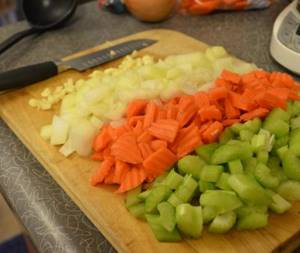
Next come the pleasant additions to the broth. The very first number is, naturally, everyone’s favorite potato, without which the first number is not the same at all. But when you add it, the satiety and nutritional value of the dish increases significantly! Thus, the calorie content of chicken soup with potatoes (even if there is nothing else floating in the broth) grows to hundreds of calories. If you add only tomatoes, cabbage and, say, bell peppers, then depending on the ratio of the components, the calories will not increase that much: by 25-30 per 100 g. Mushrooms will raise this figure to almost 40 kcal, but still this figure will not seem that's a lot when compared to how much the chicken noodle soup would add calories. All pasta products are five times more nutritious than potatoes. So eating a bowl of spider web pasta soup is like slurping down five bowls of broth and potatoes.
How to reduce calories in chicken soup?
For people who follow a healthy diet, chicken broth soup is the main dish of the daily diet. Of course, the skin of the chicken must be trimmed before cooking. After all, it is the skin that adds calories to chicken soup.
The skin from the carcass is cut off before the cooking process. After all, during the boiling and boiling of the broth, harmful and fat-containing substances pass into it. To reduce the calorie content of chicken soup, you need to boil the broth for 15-20 minutes, and then drain the first broth and pour fresh water into the pan. It is in the second broth that dietary chicken soups, borscht and cabbage soup are prepared. In this simple way, the calorie content of chicken soup can be minimized.
The calorie content of chicken broth soup will be lower if you do not fry carrots and onions during the preparation process. It has been proven that this increases the calorie content of the dish by a third. After all, frying consists of 20 percent vegetable oil, which is a fairly high-calorie product.
Benefits of soups
Vegetable soups are very beneficial for humans, as they can provide a large amount of vitamins, and they have a good effect on the human digestive system. Vegetables fried in oil or fat play an important role when preparing soup. It is known that during the cooking process many vitamins are destroyed and evaporated. And short-term frying creates a crust on the product that holds them.
Soups with the addition of pasta and rice are very satisfying, and after them the feeling of fullness does not go away for a long time, which makes them doubly useful for humans. After all, the calorie content of most soups is low, and having eaten enough of them, you can minimize the consumption of high-calorie main courses and sweets.
The taste and color of the soup largely depends on the spices and seasonings added to it. When preparing this dish, cooking time plays a big role, which should not be exceeded. After all, if you cook the soup for too long, the products included in its composition will take the form of porridge, their taste will deteriorate, and most of the vitamins and other useful substances will be destroyed.
When serving soup, you can add sour cream or mayonnaise, regardless of how, what broth it is cooked in and with what. It's a matter of taste.
Considering all the beneficial properties of soup, nutritionists recommend including this dish in your daily diet for the proper functioning of the digestive system, obtaining sufficient energy and good health. A proper lunch is never complete without properly prepared soup as the first course!
Chicken soup with egg and noodles
Vermicelli soup with chicken and egg is quite easy to prepare and at the same time it has a pleasant rich taste. The dish will provide an easy afternoon snack for the whole family as a whole.
- Chicken feet – 3 pcs.;
- Carrots – 1 pc.;
- Onion – 1 pc.;
- Purified water – 2.5 l;
- Vermicelli – 50 g;
- Quail egg – 6 pcs.;
- Peppercorns – 3 grains;
- Salt - to taste.
Pour water into a deep stainless pan and place it on the burner. Grease the chicken feet and remove the top epithelial layer.
We wash it repeatedly in cold water and throw it into a container. We send the peeled onions and peppers. Boil the broth for 25 minutes.
Without removing the paws, throw in the vermicelli, peeled and diced carrots.
Break the eggs into a separate bowl and beat lightly with a fork to combine the whites and yolks. Pour into the soup in a small stream and quickly stir the whole mixture.
